What Size Trampoline Do You Need? (Honest Advice)
Have you been asking yourself, "What size trampoline do I need?" We've got all the answers for you in this article, with expert-led tips and an honest opinion!
min read
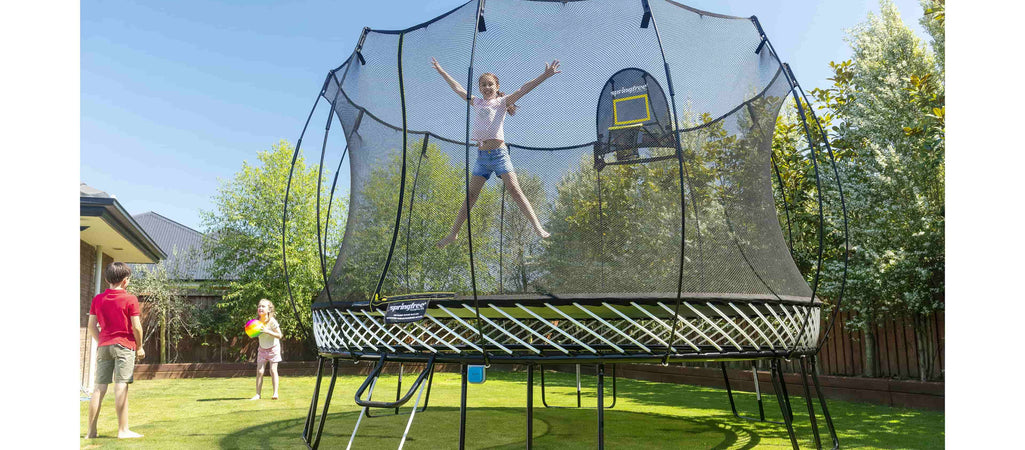
Have you been asking yourself, “What size trampoline do I need?”
This is one of the most common questions when searching for a trampoline, and it’s an important one.
Buying the wrong-sized trampoline could result in a few things, none of which are ideal:
-
A trampoline that doesn’t fit in your backyard.
-
A trampoline that cannot safely handle the weight of the jumpers.
-
A trampoline that your child grows out of and not into.
-
A trampoline that has limited space to jump or perform tricks.
We’ve crafted this article, based on our firsthand expertise, so that these unfortunate consequences do not become a reality for you.
The Different Types of Trampoline Sizes
Let’s begin by going over the different outdoor trampoline sizes you have to choose from for your next trampoline, starting from smallest to biggest:
Small Trampolines
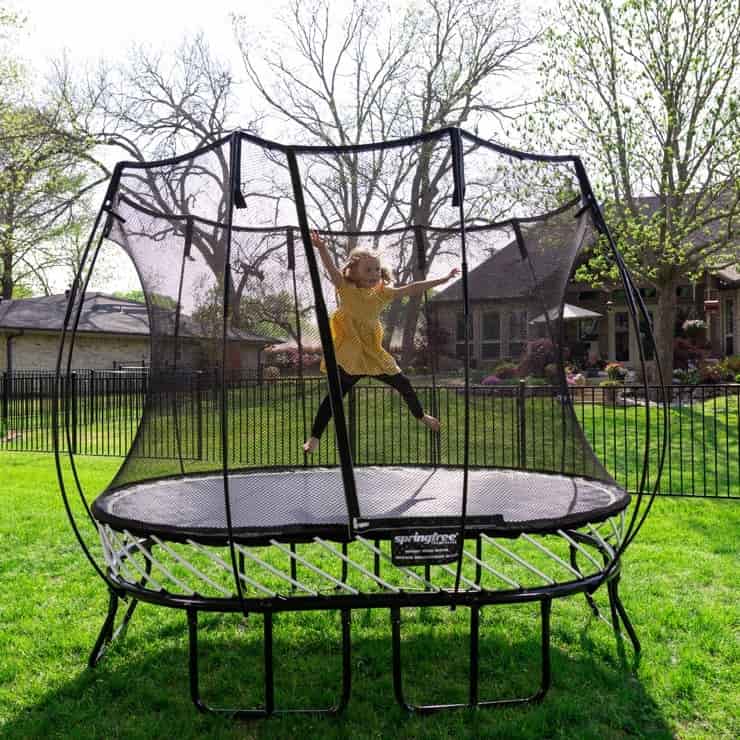
-
6 ft trampolines – The smallest common outdoor trampoline size, 6 ft trampolines are a good fit for backyards that are tight on space and want a trampoline for children around the ages of 6-8.
-
8 ft trampolines – A step above 6 ft trampolines, 8 ft trampolines are also on the smaller side and are built for smaller yards that have children around the ages of 6-10.
Check out the Springfree Mini-Round Trampoline to see what a 6 ft trampoline looks like.
Check out the Springfree Compact Round Trampoline to see what an 8 ft trampoline looks like.
Medium Trampolines
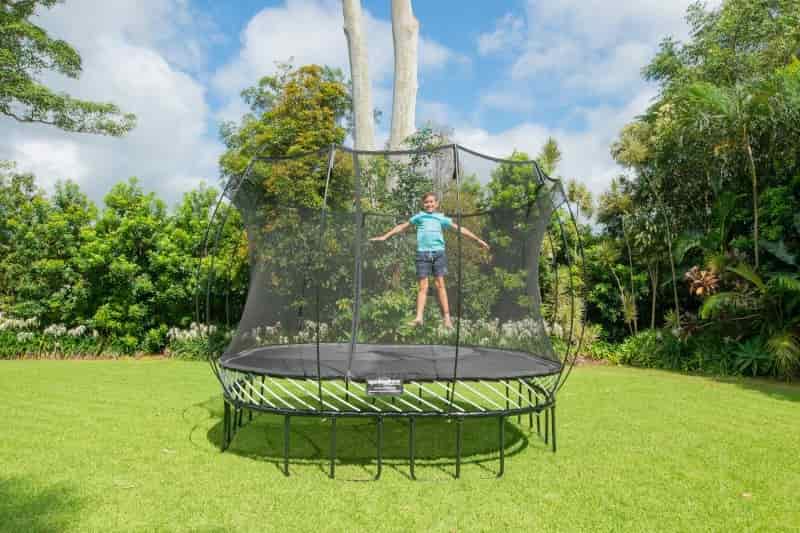
-
10 ft trampolines – The first average trampoline size, 10 ft trampolines, are for mid-sized yards that can be a fit for both kids and adults.
-
12 ft trampolines - 12 ft trampolines are a standard trampoline size that would go with a mid-sized or bigger backyard.
Check out the Springfree Medium Round Trampoline to see what a 10 ft trampoline looks like.
Check out the Springfree Large Square Trampoline to see what a 12 ft trampoline looks like.
Large Trampolines
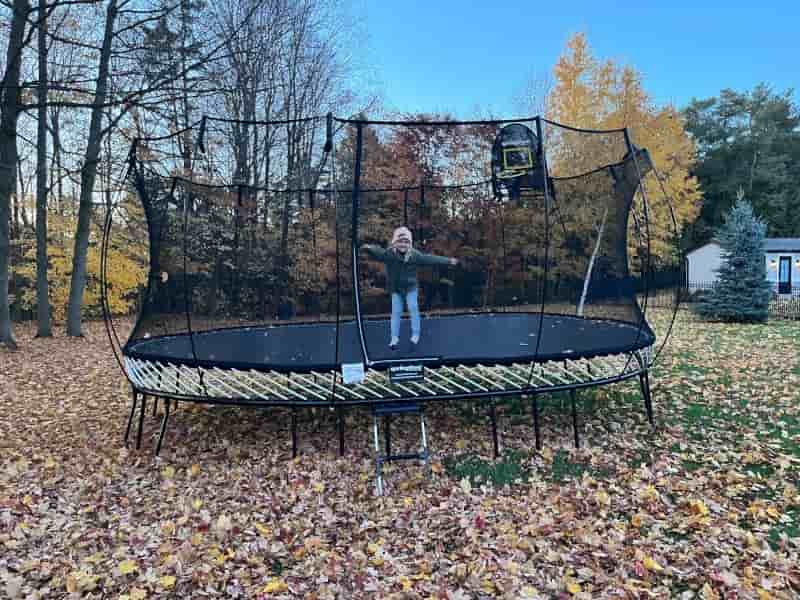
-
14 ft trampolines – 14 ft trampolines are one of the most common outdoor trampoline sizes for larger backyards that can handle jumpers of all ages.
-
16 ft trampolines – The last common outdoor trampoline size is the 16 ft trampoline, created primarily for big backyards and for families that want lots of jumping space.
Check out the Springfree Jumbo Square Trampoline to see what a 14 ft trampoline looks like.
Check out the Springfree Jumbo Oval Trampoline, which is not quite 16 ft, but will give you a sense of what an extra-large trampoline looks like:
3 Steps to Choosing the Right Trampoline Size
Now that you’ve learned about the common sizes of trampolines, let’s get into the steps for choosing the right size for your backyard:
-
Measure Your Yard
The first step that must be completed before anything else when figuring out which trampoline size to go with is measuring the size of your yard.
It’s important not to skim through this part, so let’s break down how to measure your yard for a trampoline:
How to Measure for a Trampoline
Step #1: First, find the spot in your yard where you want to place the trampoline.
We recommend that you find an area that is clear of branches, debris, fences and slopes. Here are some further recommendations for finding a spot:
-
Find a spot that is flat and even (if the space you have isn’t level, we recommend the rise/gradient be no more than three degrees across the whole space. We don’t advise installing a trampoline where the slope is greater than that).
-
Safe lateral clearance space of 3-5 ft on all sides of the trampoline.
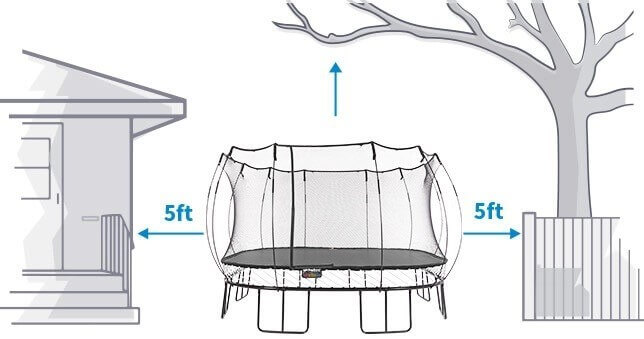
Step #2: Next, grab your measuring tape and measure the length and width of the area you want to place the trampoline.
Step #3: Once you have the measurement, add 3-5 ft more to all sides of the trampoline to account for clearance space.
(We recommend that every vertically standing obstacle, like a fence, shed or tree, have 3-5 ft of clearance space.)
Here are some important things to keep in mind when measuring your yard for a trampoline:
-
Not all trampolines are the same when it comes to space: A traditional trampoline with static metal poles will need less clearance space than a Springfree Trampoline.
-
How much clearance space you should accommodate for the trampoline is based on your trampoline manufacturer’s recommendations for clearance space. It should be in the installation instructions.
-
The space you need can also depend on who’s jumping. If your kid is an aspiring gymnast who practices flips and tricks on the trampoline, you might want to make more room than a kid who uses the trampoline to play basketball.
-
Ultimately, it's your decision on how much space you want to make for the trampoline. If you’re comfortable with the amount of space then go with what you think is best. However, there is a risk of injury if proper clearance space is not accounted for.
-
You will also want to consider which shape of trampoline fits best in your backyard. Some of the common trampoline shapes include round, square, rectangle and oval.
-
Decide Who Will Be Using the Trampoline
The next major step you need to take when deciding which trampoline size to buy is assessing who will be regularly jumping on the trampoline.
You MUST pay attention to the single jumper weight capacity, or single user weight.
This is the metric set by manufacturers that lets you know the recommended maximum weight of a jumper so you can safely jump without bottoming out.
It is calculated by taking the expected height the jumper will reach and their weight.
For example, our Springfree Jumbo Square Trampoline has a single jumper weight capacity of 220 pounds (pictured below).
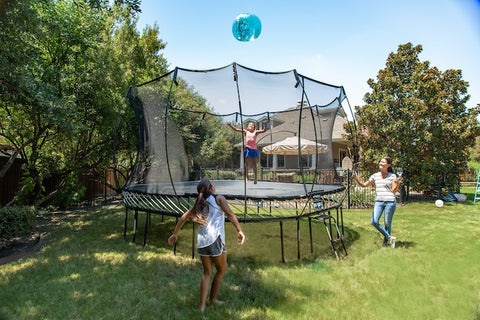
If you weighed over 220 pounds and reached maximum height on the trampoline, you be at risk of “bottoming out” or falling through the trampoline.
It doesn’t mean you can’t jump on the trampoline if you weigh over the trampoline weight limit; it just means there is a risk of bottoming out if you reach maximum height.
***What to do: Figure out the weight of all potential jumpers and find a trampoline that will safely accommodate the jumpers’ weight.
The weight limits of trampolines should be available online through the manufacturer’s website or you can contact the company you want to purchase from if you have questions.
If you’re buying a trampoline for your child, you also need to think about your child’s potential growth as they get older.
If you have a nine-year-old and want them to have a trampoline to jump on for the rest of their childhood, then you’re probably not going to want to buy an 8-foot trampoline. They will likely grow out of it in a few years.
An 8 ft trampoline:
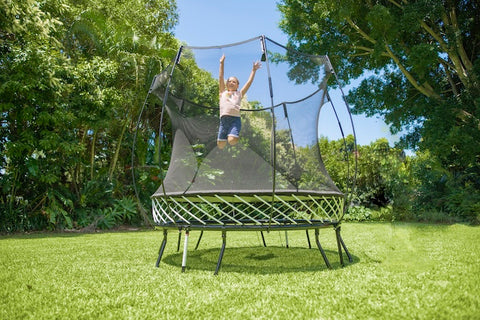
That’s why it’s worth it to go ahead and purchase a large trampoline (assuming you have the space) if you plan to keep the trampoline for the long haul.
It will ensure that you don’t have to buy another trampoline down the road when your child needs more jumping space.
Think of trampolines like clothes: It’s better to buy something your child can grow into than grow out of in a short period!
-
Consider All Other Factors
The first two steps will give you the technical information you need to find the right-sized trampoline. Now it’s time to tie in all the other factors.
After finding the size of trampoline you need, ask yourself these questions to lead you to your ideal trampoline:
-
What type of trampoline do you want—spring or springless? Above ground or inground?
-
How safe is the trampoline?
-
Is the trampoline made from quality material that will ensure its longevity throughout childhood?
-
Can this trampoline withstand years of jumping and weather conditions without breaking down?
-
How’s the design of the trampoline? Would it look good in your backyard?
-
Does the trampoline have good user reviews?
-
Finally, what’s the cost of the trampoline? Is it within your budget?
Other factors to consider: Warranty, installation, customer service and trampoline accessories.
If you would like to see these points expanded on in detail, check out our article on the seven things to consider when purchasing a trampoline.
Which Trampoline Size Is Right for You?
Determining the best size trampoline to buy is one of the most important things to figure out when searching for a trampoline.
After reading through this Trampoline Size Guide, you should be well set up to make a decision.
But wouldn’t it be great if you could actually see the trampoline in your yard before committing to buying it?
Thanks to augmented reality (AR) technology, you can now get a visual demonstration of how a trampoline would fit into your yard.
The best part? It’s free and only requires you to have a smartphone.
Access our AR Tool, follow three simple steps and you can see an accurate representation of how a trampoline would fit into your yard.


